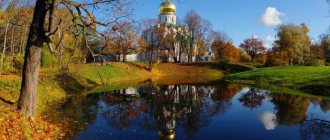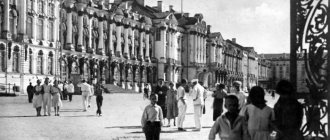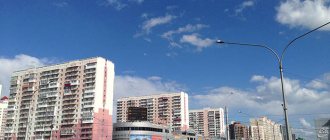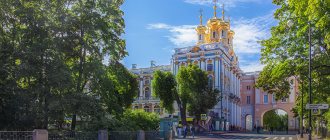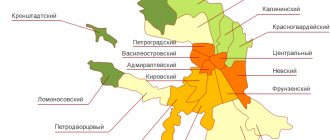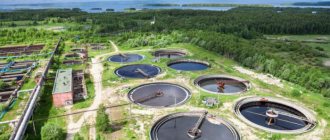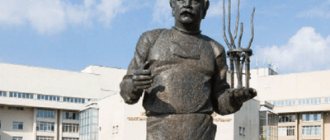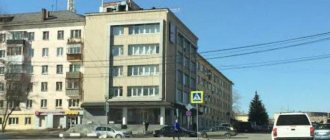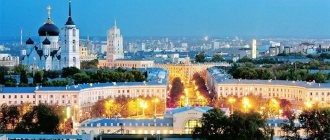Founding history
A Swedish magnate lived here from 1609 to 1702. His small estate was called Sarskaya Manor. It included a wooden house and utility buildings, a neat garden with two perpendicular paths dividing the territory into 4 squares.
The first mention of this village is contained in a document dating back to 1501. Then Peter I expelled the Swedish population and took possession of this land, transferring it into the hands of A. Menshikov. On June 13, 1710, this point appears under the name Tsarskoe Selo. It was presented to M. Skavronskaya, later the emperor’s wife Ekaterina Alekseevna. This moment is considered the founding date of Pushkin. At that time it played the role of a country residence.
Ratna Chamber
Under the last two emperors of the Romanov dynasty, after numerous imitations of Europe and the East, everything national and Russian finally came into fashion. Nicholas and Alexandra, the last royal couple of Russia, were deeply religious people, and not far from the Alexander Palace, where they lived, construction began on the Fedorov Cathedral in the ancient Russian style. There was supposed to be a large complex of buildings around it with buildings for the clergy, barracks for the Cossack convoy and many others. Tsar Nicholas decided to make one of these white stone buildings a museum glorifying the feats of arms of the Russian army. The Sovereign's War Chamber was founded in 1913; the basis of the collection of the future museum was the collection of the wife of Pavel Tretyakov's brother. The inexorable course of history changed the original purpose of the museum - in 1914, an exhibition dedicated to the life and exploits of the Russian army during the First World War opened here. The museum was of no interest to the new government after the revolution and was disbanded. Since 2008, through the efforts of the team of the Tsarskoe Selo State Museum, the restoration of the Great War Museum has been underway. The War Chamber opened to the public in 2014 to mark the centenary of the First World War.
Improvement of the object
In the period 1718-1724. The construction of the palace and the auxiliary buildings surrounding it was carried out. They were surrounded by the greenery of a picturesque garden. Between 1719 and 1722 created 2 ponds on the terrace below.
A settlement was built nearby for the palace employees. In 1716, the Assumption Church appeared. The first street, which appeared in 1720, was Sadovaya (previously called Perednyaya). During 1721, the Kuzminskaya Sloboda was established. The peasant population of the Suzdal province lived in it.
The oldest building made of stone, the Znamenskaya Church, began to be built in 1734. The city appeared here in 1808. The local museum-reserve has become a monument to urban planning. The ensemble of the 18th-20th centuries, including the park and the Catherine Palace, as well as the buildings adjacent to them, deserves no less attention.
Area, relief and climate
The area of the city of Pushkin is 201 square meters. km. It is located on the territory of the Prinevskaya lowland, to the left of the river. Not you. There are various landscape forms: plains, ridges, terraces, valleys and hills. Forests are mixed with agricultural land.
The city of Pushkin (St. Petersburg) is home to springs that feed ponds and streams. 350 million years ago (Paleozoic) there was a sea here. Clay, sands, limestone, and sandstones have survived to this day. Their layer reaches 200 m and covers a crystalline diabase, gneiss, and granite foundation. The formation of the current relief was stimulated by a cover of ice (the Valdai glaciation, which occurred 12,000 years earlier).
When thawing occurred, the Littorine Sea appeared, whose depth was 8 m greater than the current one. 4000 years ago the tide ebbed and the river appeared. The Neva is the result of post-glacial deposits. For 2.5 thousand years, right up to the present day, no changes in relief were noticed.
The local climate is characterized by moderation and humidity. It is transitional between continental and maritime. Summer doesn't last long and it's rarely hot. The winter is much longer, interrupted by thaws.
The transition periods of spring and autumn are long, so average indicators are more common for local residents. Temperatures are above freezing between April and November. The coldest month is February. The annual precipitation level is 590 millimeters.
Atmospheric currents, as a rule, are clean and fresh, enter here from the south, due to which the weather is mild. One air mass can quickly give way to another. Cyclones are frequent. The sun is least in November-January. In general, the local climate is quite comfortable for life.
Sightseeing tours
Local guides will help you organize the most informative and interesting walk around Pushkin. Together with a professional guide, you will dive deeper into the history of the city and learn unusual facts about local residents and creative personalities who studied at the Tsarskoye Selo Lyceum. Pushkin guides offer not only educational, but also thematic excursions around the city. This could be an excursion dedicated to lyceum students, or an immersion in the history of the imperial court.
Excursions around Pushkin on the Experts project. Tourister.Ru
Catherine Palace Photo: © Andrey Panin
Territorial division
You can get to the city center of Pushkin if you move northeast from the park area. It is mainly built up with buildings of 3-4 floors made of stone. Most of them were built in the pre-revolutionary period.
The main historical district is Sofia. Next to it are the streets. Parkovaya and Sapernaya, Pavlovskoye and Krasnoselskoye highways. Krasnoselka previously housed Arakcheevka, Babolova and Soboleva - private areas of the city. Pushkin is a place where, while exploring, you will stumble upon the Friedenthal colony, which belonged to the Germans. A large number of high-rise buildings on the territory of BAM. There was a private sector here. Also worthy of attention are Novaya Derevnya and Belozerka, Novoselki, which grew out of rural areas. Another historical district is Kondakopshino. In addition, there are zones called Pavlovsk-2, Lesnoye (belongs to the GPP), Novokondakopshino.
Many people may be interested in the question of which index to use? The city of Pushkin is divided into only 2 postal areas, so departments accept letters using the details: 196601 or 196609.
Transport
There are about 10 bus routes along Pushkin. Tourists will need No. 371 - from the Detskoe Selo station to the Catherine Palace and No. 378, which runs between all three parks - Ekaterininsky, Alexandrovsky and Babolovsky. The fare is 22-28 RUB depending on the route. A taxi in Pushkin will cost about 300 RUB.
A great alternative to public transport and your own legs is a bicycle. You can bring it by train from St. Petersburg, where there are many more rental companies, or rent it on the spot, but it is better to book in advance. The rental company is located in the paid parking area opposite the Catherine Park, the cost for 1 hour is 250 RUB, for 2 hours - 500 RUB, a deposit is also required. Rentals are closed in winter.
National characteristics
A 19th century guidebook indicates that the population of Pushkin (St. Petersburg) was 15 thousand people. It was unlike other cities in terms of its ethnic composition.
Bourgeois, peasant people, clergy and merchants made up 7 thousand people. The remaining half consisted of military personnel, courtiers, and colonists. It was not just a quiet place to live, but an important political point.
Local society had a special coloring. Many St. Petersburg residents came here for 3 months and left the city. In 1939, in the Leningrad region, as in the entire Soviet Union, a population census was carried out, the results of which revealed that 17,711 thousand Jews lived here. When the Germans occupied the city, they were almost completely destroyed.
Dynamics of population change
At the beginning of the 18th century, the Sarskaya manor included more than 43 villages, 6 wastelands, peasant and bobil households. Over time, the population grew. During the reign of Peter I, 200 peasant families lived here.
The composition of the village included the church parable, guard soldiers and court servants. New villages arose, where there were 71 households, consisting of immigrants and 69 from the local population.
In 1732, a census was carried out, according to the results of which there were 48 men here. In the surrounding villages, they counted 105 Latvian households, in which representatives of the stronger and fairer sex lived in a ratio of 336/343, respectively. In 1796, the Palace Settlement included 779 buildings in which 2.8 thousand people lived. Sofia became home to 1.6 thousand people. (146 dwellings).
In 1845, Colonel Zhukovsky made a report in which it was reported that, including the garrison, the population was 121.94 thousand people. Of these, 9.066 thousand were men, 3.128 thousand were women. Hundreds of families came here in the summer to relax together with the courtyard. Workers (1-1.5 thousand people) also went to Tsarskoye Selo.
Moving discord
Pushkin, both in Soviet times and now, is valued for its excellent transport accessibility. The oldest railway in the country, new trains and frequency of trains make the half-hour journey to Vitebsky Station quite convenient. As an alternative, there are minibuses and buses going to the Moskovskaya metro station either along Vitebsky Prospekt or along Pulkovskoye Shosse.
The only, and quite important, problem is the lack of overpasses over the railway (or tunnels under it), which cuts the city into two unequal parts. Unfortunately, it has not yet been possible to solve it - there is not even a project.
There is also a certain lack of social infrastructure. It is aggravated by the fact that residents of Slavyanka, Lensovetovsky and Shushar bring their children to Pushkin, where the situation with schools and kindergartens is even worse. There is no normal shopping and entertainment complex or hypermarkets in the city. This is especially strange considering that about 100 thousand people now live here.
XX - early XXI centuries
In 1909 there were 31,201 thousand people here. Of these, 2.8 thousand were noble class, 309 were clergy, 691 were citizens with an honorary title, 241 were merchants, 2.505 thousand were bourgeois, 13.653 thousand were peasants, 52 were colonists, 8.169 thousand were military personnel. , 1.369 thousand were retirees. Foreigners with families – 237 people. Other population groups – 209 people.
The number of people increased, and within a century there were 108.3 thousand people here. 93.8 thousand people lived directly in the city of Pushkin.
The territories of Pavlovsky and Pushkinsky districts were united into a single administrative unit. In 2001, the total number of people was 124.3 thousand citizens.
In 2002, a count was carried out again, showing a total of 116,811 thousand (in the Pushkinsky district there were 100,097 thousand people). Of these, 56% were of working age. This was the moment of the first positive changes in the birth rate (it increased by 5%).
Subsequently, positive population dynamics were observed: 2003 – 84.6 thousand people, 2006 – 110.9 thousand people.
Closer to our days
The number of people living here has changed due to the rapid development of construction.
According to 2008 data, 1.278 thousand people were born, which exceeded the results of 2007. However, in order for Pushkin’s population to reproduce properly, the figure had to double. 285 people born from extramarital unions. In 60% of cases, both parents applied for registration.
In 2009, 1,471 couples entered into a marriage union, and 742 were dissolved.
There are more women than men. Of the total number, they are 54%, which is 4.5 thousand people. exceeds the number of representatives of the stronger sex. These are mostly people of non-working age. Representatives of the fair sex live longer.
The population of Pushkin has an average age of 40 years. Based on demographic and social indicators, we can talk about its aging. If the trend does not change, senior citizens will soon make up a third of the total population. In 2009, 19,316 thousand foreigners registered for migration. 1,377 people came here in search of work, 435 people received Russian citizenship.
Since 2012, a steady increase in the number of people has been noticeable:
- in 2012, the population of Pushkin was 95.239 thousand people;
- 2013 – 97.34 thousand people;
- 2014 – 100.753 thousand people;
- 2015 – 101, 101 thousand people.
In 2016, the population of Pushkin is 102.729 thousand people. Of these, 63% are able-bodied. 13% are still too young to work, 24% are already old.
Buy a ticket from the railway station in Pushkin (Tsarskoe Selo)
There are five ticket office windows in the station building. You can purchase travel documents there from 05:00 to 00:30. In addition to ticket offices, the station has self-service terminals that sell single train tickets. With their help, you can buy a round-trip ticket, choose a child fare, pay for luggage, a bicycle or a pet. Terminals sell tickets no more than 10 days before the travel date. Russian Railways offers to pay for travel using online services and purchase a ticket on the website or using one of the mobile applications: “Suburban” or “RZD Passengers”. Many travelers appreciate the opportunity to purchase long-distance tickets using the Tutu service. Ru, where you can compare options and reviews from passengers.
©
Social support measures
Regional and federal authorities are faced with numerous tasks, as a result of which Russia (the city of Pushkin, in particular) will be transformed in terms of demography. Considerable attention is paid to family issues and providing parents with financial assistance.
Families are paid 15 different subsidies. Assistance is provided in supporting children while studying at school. Organizations are developing that are involved in protecting society, improving the quality of life, creating educational institutions, centers for improving health and sports. Massive events are held that emphasize the benefits of starting a family.
Many more problems remain unresolved. It is extremely important to address them as soon as possible in order to ensure an increase in the working-age population, which the city of Pushkin (St. Petersburg) desperately needs. Social guarantees for families with children are important due to the growing number of elderly citizens. In this case, young couples will not be afraid of financial difficulties when having a child.
How to get to Pushkin
Pushkin is the closest suburb of St. Petersburg.
Minibuses depart from the Moskovskaya metro station every 5 minutes, and electric trains depart from Vitebsky and Baltiysky stations, which spend no more than half an hour on the way. Transport runs from early morning until late at night, so you can take your time and explore the sights in peace. From Moscow everything is also simple: from Pulkovo airport to the station. metro station "Moskovskaya", and then - to Pushkin by bus or directly to the place by taxi. More information about transport, schedules and prices can be found at this link.
